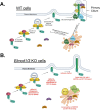The ARF GAPs ELMOD1 and ELMOD3 act at the Golgi and cilia to regulate ciliogenesis and ciliary protein traffic
- PMID: 34818063
- PMCID: PMC9236152
- DOI: 10.1091/mbc.E21-09-0443
The ARF GAPs ELMOD1 and ELMOD3 act at the Golgi and cilia to regulate ciliogenesis and ciliary protein traffic
Erratum in
-
The ARF GAPs ELMOD1 and ELMOD3 act at the Golgi and cilia to regulate ciliogenesis and ciliary protein traffic.Mol Biol Cell. 2022 Jun 1;33(7):cor1. doi: 10.1091/mbc.E21-09-0443_corr. Mol Biol Cell. 2022. PMID: 35612986 Free PMC article. No abstract available.
Abstract
ELMODs are a family of three mammalian paralogues that display GTPase-activating protein (GAP) activity toward a uniquely broad array of ADP-ribosylation factor (ARF) family GTPases that includes ARF-like (ARL) proteins. ELMODs are ubiquitously expressed in mammalian tissues, highly conserved across eukaryotes, and ancient in origin, being present in the last eukaryotic common ancestor. We described functions of ELMOD2 in immortalized mouse embryonic fibroblasts (MEFs) in the regulation of cell division, microtubules, ciliogenesis, and mitochondrial fusion. Here, using similar strategies with the paralogues ELMOD1 and ELMOD3, we identify novel functions and locations of these cell regulators and compare them to those of ELMOD2, allowing the determination of functional redundancy among the family members. We found strong similarities in phenotypes resulting from deletion of either Elmod1 or Elmod3 and marked differences from those arising in Elmod2 deletion lines. Deletion of either Elmod1 or Elmod3 results in the decreased ability of cells to form primary cilia, loss of a subset of proteins from cilia, and accumulation of some ciliary proteins at the Golgi, predicted to result from compromised traffic from the Golgi to cilia. These phenotypes are reversed upon activating mutant expression of either ARL3 or ARL16, linking their roles to ELMOD1/3 actions.
Figures






Similar articles
-
Roles for ELMOD2 and Rootletin in ciliogenesis.Mol Biol Cell. 2021 Apr 15;32(8):800-822. doi: 10.1091/mbc.E20-10-0635. Epub 2021 Feb 17. Mol Biol Cell. 2021. PMID: 33596093 Free PMC article.
-
Characterization of recombinant ELMOD (cell engulfment and motility domain) proteins as GTPase-activating proteins (GAPs) for ARF family GTPases.J Biol Chem. 2014 Apr 18;289(16):11111-11121. doi: 10.1074/jbc.M114.548529. Epub 2014 Mar 10. J Biol Chem. 2014. PMID: 24616099 Free PMC article.
-
Phylogenetic profiling and cellular analyses of ARL16 reveal roles in traffic of IFT140 and INPP5E.Mol Biol Cell. 2022 Apr 1;33(4):ar33. doi: 10.1091/mbc.E21-10-0509-T. Epub 2022 Feb 23. Mol Biol Cell. 2022. PMID: 35196065 Free PMC article.
-
ARF family GTPases with links to cilia.Am J Physiol Cell Physiol. 2020 Aug 1;319(2):C404-C418. doi: 10.1152/ajpcell.00188.2020. Epub 2020 Jun 10. Am J Physiol Cell Physiol. 2020. PMID: 32520609 Free PMC article. Review.
-
ARF family G proteins and their regulators: roles in membrane transport, development and disease.Nat Rev Mol Cell Biol. 2011 Jun;12(6):362-75. doi: 10.1038/nrm3117. Epub 2011 May 18. Nat Rev Mol Cell Biol. 2011. PMID: 21587297 Free PMC article. Review.
Cited by
-
CNKSR2 interactome analysis indicates its association with the centrosome/microtubule system.Neural Regen Res. 2025 Aug 1;20(8):2420-2432. doi: 10.4103/NRR.NRR-D-23-01725. Epub 2024 May 17. Neural Regen Res. 2025. PMID: 39359098 Free PMC article.
-
RBM22, a Key Player of Pre-mRNA Splicing and Gene Expression Regulation, Is Altered in Cancer.Cancers (Basel). 2022 Jan 27;14(3):643. doi: 10.3390/cancers14030643. Cancers (Basel). 2022. PMID: 35158909 Free PMC article. Review.
-
ELMOD3-Rab1A-Flotillin2 cascade regulates lumen formation via vesicle trafficking in Ciona notochord.Open Biol. 2023 Mar;13(3):220367. doi: 10.1098/rsob.220367. Epub 2023 Mar 15. Open Biol. 2023. PMID: 36918025 Free PMC article.
-
A phylogenetic profiling approach identifies novel ciliogenesis genes in Drosophila and C. elegans.EMBO J. 2023 Aug 15;42(16):e113616. doi: 10.15252/embj.2023113616. Epub 2023 Jun 15. EMBO J. 2023. PMID: 37317646 Free PMC article.
-
Gene regulation analysis of patient-derived iPSCs and its CRISPR-corrected control provides a new tool for studying perturbations of ELMOD3 c.512A>G mutation during the development of inherited hearing loss.PLoS One. 2023 Sep 14;18(9):e0288640. doi: 10.1371/journal.pone.0288640. eCollection 2023. PLoS One. 2023. PMID: 37708136 Free PMC article.
References
-
- Bielas SL, Silhavy JL, Brancati F, Kisseleva MV, Al-Gazali L, Sztriha L, Bayoumi RA, Zaki MS, Abdel-Aleem A, Rosti RO, et al. (2009). Mutations in INPP5E, encoding inositol polyphosphate-5-phosphatase E, link phosphatidyl inositol signaling to the ciliopathies. Nat Genet 41, 1032–1036. - PMC - PubMed
Publication types
MeSH terms
Substances
Grants and funding
LinkOut - more resources
Full Text Sources
Molecular Biology Databases
Research Materials
Miscellaneous

